Update and Warning!: Lazaros Polymenakos writes:
While lowering and raising the mast, the mast has a tendency of going off the boat's axis. Unfortunately,
the first time I tried to raise the mast without a fully rigged gin pole and bridle, the
mast swong rapidly to the port side, producing a horizontal crack on the right (starboard) side,
about 3-4cm long, and about 2-3 cm above the base of the mast. The same thing happened to the mast
of another f210.
The damage is on the mast itself, not the base. Apart from the crack, the starboard rivet was torn out.
However, I hear from others that this problem is common and frequent and I think a solution should be sought
and made public.
Title: Mast Raising/Lowering System
Author: Terry F. Ellis
The F210 trailer came with a nifty mast raising/lowering system. It
is almost essential to use this system to raise/lower the mast. That is
because the mast is approximately 30 feet long while the boat's center
line length is only about 18 feet long. From the mast step, you only have
about 10 feet of mast "leverage". Although the mast only weighs about 60
lbs, the 20 feet hanging over the transom makes it very difficult to raise
and/or lower! Beneteau solved that with the mast raising/lowering system.
Some F235 owners have patterned a similar system for their boats (which
have "almost" identical mast sections, rig dimensions, shrouds, stays,
etc. as the F210). They could possibly purchase the mast raising gear for
the F210 (now known as F211) from Beneteau for use on their F235s. Or they
could look at the drawings for it in an F210 manual and replicate it.
The F210 mast raising/lowering gear consists of an 8' long galvanized
steel "gin pole". It sits on the front of the mast while a tubular mast
crutch with a rubber roller cradle and adjustable 1" tubes sits in metal
"cups" permanently installed on the transom deck. You insert two temporary
8' shrouds into T-ball slots in the mast to hold it in column while raising/lowering
(with metal rings to tie temporary lines led to the front of the gin pole
and aft, to jib fair lead blocks). The trailer winch stand has a forward
mast cradle post that is some 10 feet high. It has a rubber roller through
which you run the tow strap to the leading edge of the gin pole. You attach
a halyard to the leading edge of the gin pole as well. The tow strap holds
the pole down while the halyard holds it up. The temporary shrouds with
attached pole lines and jib sheets secure the pole abeam. With the gin
pole in place, you crank the winch clockwise and the mast raises and settles
in the mast step, hinging on the mast step pin.
Reverse this procedure and the mast hinges itself back down to the transom
cradle. You leave the mast upper/lower and back stays attached while raising/lowering.
You only fasten/unfasten the forestay.
When the mast is lowered and resting on the roller atop the stern mounted
mast crutch, you remove the mast base hinge pin. The mast base thus released
from the mast step, you pull the mast forward to a rubber cradle atop the
trailer winch stand. As you do so, the mast rolls on the stern mounted
mast crutch roller. Once centered on the boat for trailering, you remove
two extension tubes on the stern crutch and tie the mast securely fore
and aft.
After raising the mast and pinning the forestay, you remove the stern
mounted mast crutch extension tubes and roller from the cups in the stern
deck. Under sail, there are two 1" cup holders (for the mast crutch) showing
on the stern deck. They are flush mounted and of polished stainless steel.
I've always thought they could be used to hold stern mounted flags! But
I've not done so...yet!
This may sound complicated or even expensive, but it is not. The transom
crutch/poles and temporary shrouds/lines are light and easy to store away.
The gin pole attaches with a spring pin on the trailer frame, out of the
way when not in use. Of course the tow line roller and forward mast cradle
are permanently attached to the trailer winch post (which also serves as
a "step ladder" to climb up on the bow while the boat sits on the trailer).
A picture of the system is contained in the Factory Commissioning Manual
(See "Factory Commissioning Manual" for F210 elsewhere in this site library).
With this system, I can raise/lower the mast on my F210 in a few minutes,
single handedly! A second person makes it even easier. Contact Beneteau
Customer Service at http://www.beneteauusa.com to see if they will send
you diagrams or if you can purchase the unit from them.
You can "view" the pictures below to see my description of the system
and some drawings of how it's rigged on my boat. Perhaps you could use
this to rig a system which works on your boat.
Terry Ellis
F210 MAST RAISING/LOWERING SYSTEM INSTRUCTIONS
1. GIN POLE 8' LONG. RUBBER FOOT TO REST ON MAST DURING RAISING/LOWERING.
METAL RING ON FORWARD END TO ATTACH TRAILER WINCH STRAP (LOWER RING), SPINNAKER
OR JIB HALYARD (UPPER RING), STB MAST BRIDLE (RIGHT OUTTER RING) AND PORT
MAST BRIDLE (LEFT OUTTER RING).
2. BRIDLE 5/32" SS SHROUD WIRE WITH SS RING ATTACHED AT LOWER END AND
T-BALL AT UPPER END (T-BALL RECEPTACLE PERMANENTLY INSTALLED APPROX. 6'
UP FROM MAST BASE ON PORT AND STB SIDES OF MAST).
3. TRANSOM MOUNTED 1 "" SS TUBE MAST CRUTCH BAR W/RUBBER ROLLER FOR
MAST CRADLE APPROXIMATELY 48" WIDE AT TOP PLUS 4 EXTENSION TUBES APPROXIMATELY
24" EACH WHICH INSERT INTO ONE ANOTHER AND INTO CROSS CRUTCH BAR. USE ALL
FOUR TO RAISE/LOWER MAST, GIVING PROPER LEVERAGE. REMOVE TWO AND LOWER
MAST APPROX 24" AT TRANSOM FOR TRAILERING.
4. TWO, 3/8" DACRON LINES APPROX. 8' LONG WHICH TIE TO FRONT END RING
OF GIN POLE AND TO RINGS ON TEMPORARY SIDE SHROUDS.
5. USE EXISTING JIB SHEETS TIED TO TEMP SHROUD RINGS, RUN THROUGH JIB
FAIRLEAD BLOCKS SET PERPENDICULAR TO AFT END OF MAST BASE AND THROUGH SPIN
LOC SHEET STOPPERS ATOP DECK.
6. USE EXISTING SPINNAKER OR JIB HALYARD SHACKLED TO END OF GIN POLE
AND CLEATED ON MAST CLEAT TO HOLD POLE UP IN POSITION.
7. USE EXISTING NYLON TRAILER TOW STRAP RUN THROUGH ROLLER ON WINCH
STAND OF TRAILER TO FRONT END OF GIN POLE TO HOLD END OF GIN POLE DOWN.
8. TENSION HALYARD AND JIB SHEETS EVENLY PRT/STB CAUSES RUBBER FOOT
OF GIN POLE TO STAY IN PLACE ON FRONT OF MAST AND CAUSES TEMP SIDE STAYS
TO KEEP MAST PLUMB WHILE RAISING/LOWERING.
9. TRAILER WINCH HAS FWD/REVERSE AWL TO PREVENT INADVERTENT SLIPPING
WHEN EITHER RAISING OR LOWERING MAST.
10. USE MAST STEP PIN IN PLACE AS MAST HINGE AND REMOVE/REPLACE FORESTAY
CLEVIS PIN ONLY WITH TENSION ON GIN POLE WITH TRAILER TOW STRAP, HALYARD
AND BRIDLE LINES.
11. BEFORE/AFTER RAISING, STORE GIN POLE ON PINS UNDER TRAILER FRAME
AND BRIDLE/LINES/TEMP STAYS AND DISASSEMBLED TRANSOM MAST CRUTCH IN BOX.
12. ALWAYS ENSURE MAST UPPER/LOWER SHROUDS AS WELL AS BACK STAY ARE
FREE OF KINKS AND WILL RUN FREE ON DECK CHAIN PLATES . NEVER FORCE MAST
IF ENCOUNTER PRESSURE. THE MAST WILL RAISE/LOWER VERY EASILY WITH TRAILER
WINCH... TAKES MINIMAL ARM STRENGTH TO DO SO.
13. HAVING A SECOND PERSON ON DECK HELPS TO PREVENT SNAGGING OF LINES/STAYS
AND TO ALIGN MAST PIN WITH MAST STEP.
14. REMOVING AND INSERTING MAST HINGE PIN IS THE MOST DIFFICULT OF ALL
THESE RELATIVELY EASY PROCEDURES. ONE PERSON CAN RAISE/LOWER MAST WITH
THIS SYSTEM IN APPROXIMATELY 15 TO 30 MINUTES.
210mrp1.gif
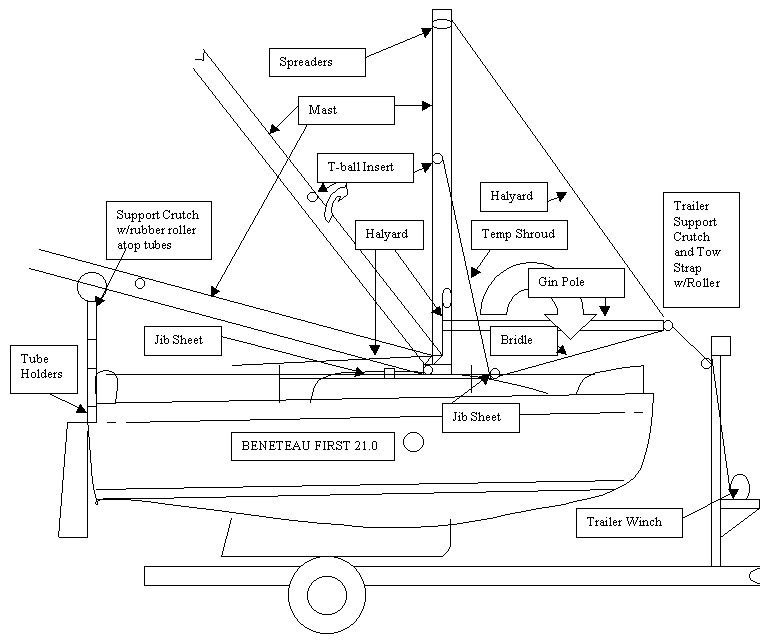
210mrp2.gif
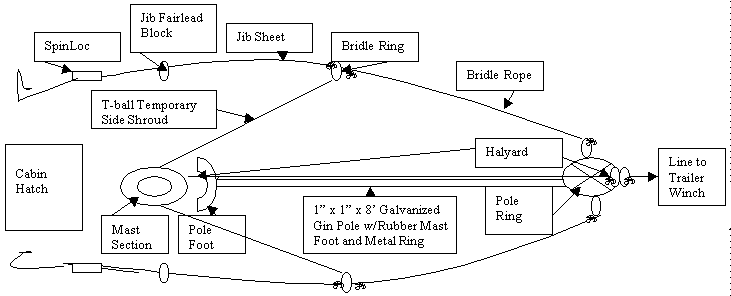
210mrp3.gif
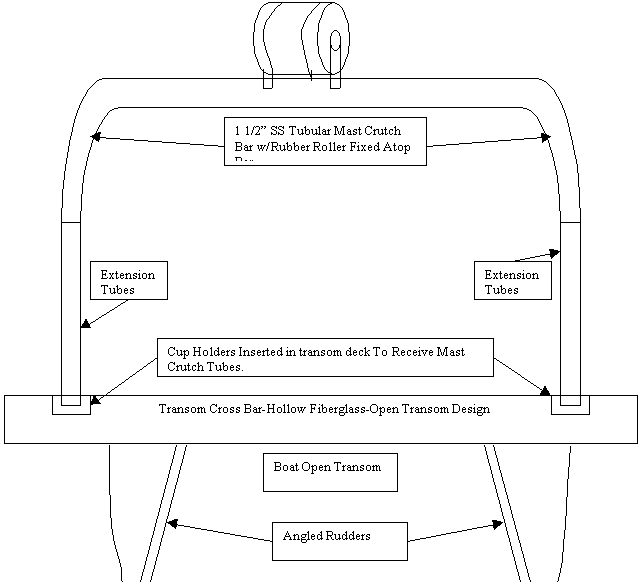
210mrp4.gif
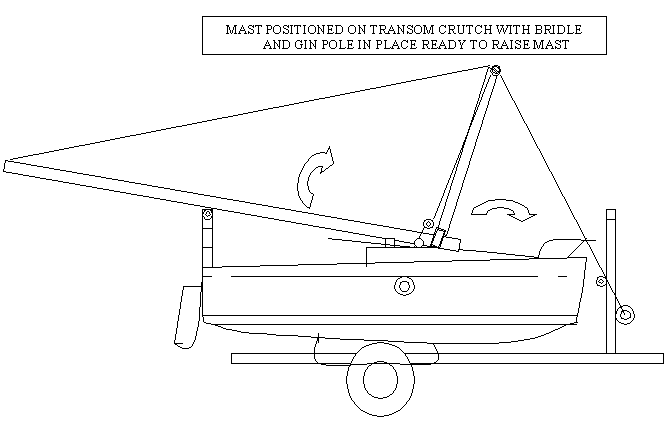
210mrp5.gif
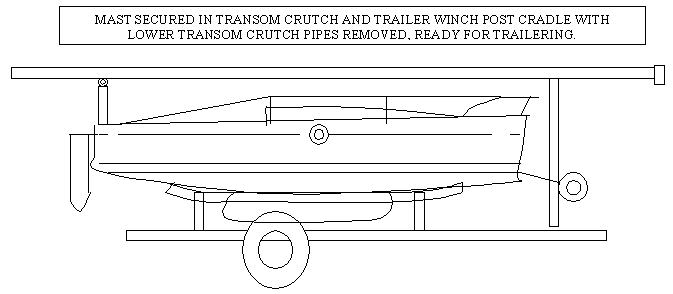
Title: Mast Raising/Lowering System
Model(s): First 21 Classic; First 210; First 211 Spirit; First 235
System(s): Rigging & tuning
Author: Terry F. Ellis